There is an urgent need to address the multiple conditions that lie behind migration from the Horn of Africa to the Gulf Monarchies. The journey from the Horn of Africa through Yemen and onwards to the Gulf monarchies accounts for 40% of all migratory movements worldwide and has seen a constant increase over the past few years.
The main driver is economic need. Coming from countries in which decades of conflict and political instability have negatively affected economic wealth, the rich Gulf monarchies seem to offer opportunities for a dignified life. Other drivers include climate change, natural hazards, violence, and conflict (especially against certain ethnic groups). Finally, another factor is food and water insecurity, which has been especially affecting rural populations.
Many of the migrations from the Horn of Africa to the Arabian Peninsula are illegal in character. The reasons why many migrants have been choosing irregular channels of migration are mainly connected to the limited options for regular migration as well as the administrative challenges associated with those few options (e.g., strict exit control procedures). Illegal migrants from the Horn of Africa typically rely on smugglers to make their journey towards the Arabian Peninsula. As they do so, they become particularly vulnerable to human trafficking. Significantly, exposure to the risk of trafficking is observed at three distinct moments along the journey.
Transiting through Djibouti and Somalia
Some of the most common forms of trafficking are sex trafficking (in which substances are often used as a means of coercion) and forced labor, particularly domestic servitude, forced begging, and peddling. Migrant men are also victims of hazardous forced labor in construction sites, in manual jobs in the Port of Djibouti, and in other informal sectors of the local economy.
Migrant girls and women are especially vulnerable to commercial sexual exploitation. In Djibouti, they are predominantly exploited in bars, hotels, and nightclubs frequented by Djiboutian nationals as well as by foreigners who work in the shipping industry, in foreign military bases, and in transportation.
Migrant children, for their part, are most commonly exploited in the worst forms of child labor, including forced street begging. Besides begging, migrant children are exploited in agriculture, construction, commercial sex, and domestic work. In Somalia, Ethiopian children of the Oromia ethnicity have also been exploited in forced bagging and petty trade.
Transiting through Yemen
On Yemen’s shores, migrants are met and captured by traffickers, who pay a fee to the smugglers to “buy” them and later exploit them for their own economic return. Once Yemen’s traffickers get their hands on migrants they load them into trucks and drive them to ramshackle compounds.
There, men and women are typically exploited in forced labor, as domestic workers, in construction sites, in khat plantations, and in ports. In many of those instances, traffickers reportedly collect the migrant’s wages, subjecting them to debt bondage. Migrants are also forced into criminality, including transporting weapons and drugs within Yemen. Women, moreover, are exploited in sex trafficking and in sexual slavery, with wealthy Yemeni men as clients. Physical violence is also commonly reported among African migrants.
Arriving in the rich Gulf monarchies
Those who manage to cross into Saudi Arabia find themselves in a new ordeal. Their status as illegal migrants condemns them to a situation of vulnerability in which most men find themselves working as laborers in construction sites in which they are not given protective gear, they earn a below-minimum wage, engage in hazardous tasks, are denied the protection that a contract affords, and are forced to work long hours, up to 60-70 hours per week.
Most women end up working as domestic servants, where they are often underpaid or unpaid and are forced to work on average, 115 hours per week. In many cases, employers also subject migrant domestic workers to verbal and physical abuses, withhold their documents, and threatening to report them to the police, which will imprison and deport them.
Children crossing the border illegally are exposed to the risk of exploitation in forced begging, into which they are recruited by traffickers who run organized begging rings. This form of exploitation becomes especially prevalent during the holy month of Ramadan and the Muslim pilgrimages of Hajj and Umrah.
Conclusion
Considering the reality of human trafficking to which illegal migrants crossing the Gulf of Aden are exposed, there is an urgent need to address the multiple conditions that lie behind their decision to migrate. Countries of origin in the Horn of Africa will need to address the climate crisis, invest greater resources in development initiatives, spend more on healthcare, education, and rural infrastructure, and invest efforts in addressing protracted situations of conflict and political instability.
Countries of transit and countries of destination should strengthen their commitments to fight human trafficking and should comply with their responsibilities under international human rights law. They should also fight corruption among police officials and improve border control with particular attention devoted to migrant protection. They should also introduce more regular options for migration in order to decrease migrants’ dependency on smugglers.
For its part, the international community needs to give greater consideration to the Eastern Route, which has largely been neglected among other global crises, and exert greater pressure on the Gulf monarchies. It should also inform migrants about the risks of irregular migration across the Gulf of Aden and raise awareness on regular migration channels where those are available.




